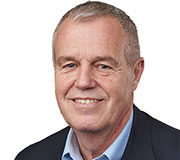
Seeing is Believing: Why Compounding Delivers Magical Results
July 21, 2017

By Joe Twidwell
Senior Vice President & Trust Officer
Everyone loves a good magician. Even if we don’t believe in magic, there is something about being swept up in the idea that there is more than what meets the eye, whether the fun comes in the trick—or in trying to figure it out.
I feel the same way about compounding.
Compounding allows investors, particularly young investors, to grow their accounts at an exponential rate. Sound like hocus pocus? It’s not. It’s actually simple (and not so simple) math.
To put it simply, compounding is the process of reinvesting an asset’s earnings in order to grow your initial investment exponentially. It’s not only great for those folks just starting out; it’s great for everyone.
Let me pull back the curtain and show you how regularly investing a modest amount of money can cause it to grow 10 times or more over the years:
Compounding may not be as dramatic as pulling a rabbit out of a hat, but the money that appears instead is much more exciting.
Compounding may not be as dramatic as pulling a rabbit out of a hat, but the money that appears instead is much more exciting.
Meet Bob and Mary. They are identical twins in every way except for the way they handle their money.
At age 25, Bob starts to saves $100 a month for ten years. He puts it into a mutual fund that has historically averaged a net return of 7.5% per year (S&P 500 average 1/1/97 thru 1/1/2017). At age 35, Bob decides to stop adding to his savings and to use the $100 a month to make improvements to his house instead. His mutual fund money remains invested and untouched.
At the exact same time, Mary at age 25 decides that she would like to get a graduate degree that will take ten years to pay off. At age 35, Mary begins to save $100 per month and invests it into the same mutual fund as Bob. Mary continues saving $100 a month until she reaches age 65.
At their 65th birthday, both Bob and Mary decide it is time to retire. Bob and Mary compare their accounts. Bob has saved $12,000 of his own money while Mary has saved $36,000 of her money.
Now, who has the bigger retirement account at 65?
You want to say Mary, right? But you also know this article is about how amazing compounding can be for your savings goals. And that’s why Bob ultimately has more in his account—$26,390 more. At age 65, Bob has $171,758 while Mary has only $144,679 (assuming annual compounding).
Here’s how. It is because of the “magic” of compounding plays up earnings on earnings. Bob started 10 years earlier and, even though he invested 60% less of his own money than Mary, his 10-year head start had already earned $6,249 during the first ten years.
Now, if you’re 25 years old, this is a good lesson for you. Start now and save consistently in the right investment vehicles. If you’re in your 30s, 40s, 50s or later, it’s never too late to take advantage of what compounding can do for you. The lesson for all of us is this: Start saving as soon as possible and leave the investment for as long as possible. An old saying says “There is no such thing as a free lunch.” While that may be true, compounded savings can result in lots of free dinners!
START SAVING FOR YOUR FUTURE
Compounding may not be as dramatic as pulling a rabbit out of a hat, but the money that appears instead is much more exciting. If you would like to discuss compounding or any other opportunities to save for your future, please call us at (712) 277-6586 or contact Security National Bank Wealth Management online. For over 130 years, Security National has helped families and business make dreams come true.